Part I by BradleyTucker:Judy Chicago made what is to be considered the first epic feminist artwork. This work has toured over 16 countries and been viewed by more than 15 million people. Chicago worked with many influential feminist artists of the time to create her masterpiece. The triangular shape renders one of the earliest shapes associated with female, and it represents true equality from all sides.Each place setting features a table runner embroidered with the woman’s name and images or symbols relating to her accomplishments, with a napkin, utensils, a glass or goblet, and a plate. Many of the plates feature a butterfly- or flower-like sculpture as a vulva symbol. A collaborative effort of female and male artisans, The Dinner Party celebrates traditional female accomplishments such as textile arts (weaving, embroidery, sewing) and china painting, which have been framed as craft or domestic art, as opposed to the more culturally valued, male-dominated fine arts.

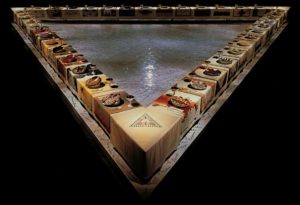
Part II & III co-authored by Taylor Virden (t.p.v)
The link above is to the Brooklyn Museum which provides both an in-depth explanation of the components accompanied with the detailed visuals that combine to create Judy Chicago’s The Dinner Party exhibit. Part II is a brief description of The Dinner Party and it’s components. Part III is very descriptive analysis of each component found in Chicago’s exhibit where below each component’s analysis I have provided specific links that will navigate the viewer to more visuals and information on the components behalf.
Part II
Components of the Dinner Party
The Dinner Party by Judy Chicago is an icon of feminist art, which represents 1,038 women in history—39 women are represented by place settings and another 999 names are inscribed in the Heritage Floor on which the table rests. This monumental work of art is comprised of a triangular table divided by three wings, each 48 feet long.
 Entry Banners:
Entry Banners: Six woven banners hang in procession, welcoming visitors to
The Dinner Party.
 Place Settings:
Place Settings:The principal component of
The Dinner Party is a massive ceremonial banquet arranged in the shape of an open triangle—a symbol of equality—with a total of thirty-nine place settings.
 Heritage Floor:The Dinner Party
Heritage Floor:The Dinner Party rests upon the Heritage Floor; inscribed on the tiles in gold luster are the names of 999 mythical and historical women of achievement who correlate to the 39 women represented in the place settings.
 Heritage Panels:
Heritage Panels:The seven Heritage Panels are large-scale hand-colored photo-and-text collages that portray the lives of the mythical and historical women whose names are inscribed in the Heritage Floor of
The Dinner Party.
 Acknowledgement Panels:
Acknowledgement Panels:The Acknowledgment Panels depict the 129 members of the creative and administrative team that worked on
The Dinner Party.
Part III
Entry Banners
Six woven banners (5’ 6” x 3’ 6” each) hang in procession, welcoming visitors to The Dinner Party. Designed by Chicago, the tapestries repeat the red, black, and gold tones associated with The Dinner Party and incorporate motifs found throughout the piece, such as triangular, floral, and abstracted butterfly forms. After painting the images on paper and selecting the thread colors, Chicago transferred her designs to graph paper, creating cartoons (patterns weavers use), which were then attached to the back of the warped looms.
The Entry Banners were woven at the San Francisco Tapestry Workshop, the first workshop in America to provide training in Aubusson tapestry technique, a high-warp (or vertical) weaving popular during the Renaissance. Judy Chicago was inspired to use Renaissance pictorial weaving when she discovered that women were prohibited from working on the high-warp looms. Custom-built looms were designed by Jean Pierre Larochette, director of the San Francisco Tapestry Workshop, and built by Ken Gilliam. These looms allowed The Dinner Party weavers, who were all trained at the Workshop, to see the designs as they worked, a method not afforded early Aubusson weavers who worked from behind the looms. This change was in keeping with Chicago’s feminist principles, which involved respect for the weavers’ agency in translating the artist’s images into thread.
Woven into the banners are a series of phrases intended to convey Chicago’s vision for a equalized world, one in which women’s history and perspectives are fully recognized and integrated into all aspects of human civilization. A line from the following text is depicted in each tapestry respectively:
And She Gathered All before Her (seen below)
And She made for them A Sign to See
And lo They saw a Vision
From this day forth Like to like in All things
And then all that divided them merged
And then Everywhere was Eden Once again
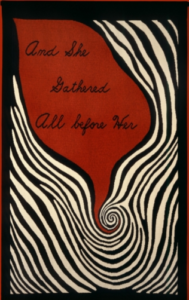
For more visuals on the Entry Banners click here:
https://www.brooklynmuseum.org/eascfa/dinner_party/entry_banners
———————————————————————————————————————————————————
Place Settings
The principal component of The Dinner Party is a massive ceremonial banquet arranged in the shape of an open triangle—a symbol of equality—measuring forty-eight feet on each side with a total of thirty-nine place settings. The “guests of honor” commemorated on the table are designated by means of intricately embroidered runners, each executed in a historically specific manner. Upon these are placed, for each setting, a gold ceramic chalice and utensils, a napkin with an embroidered edge, and a fourteen-inch china-painted plate with a central motif based on butterfly and vulvar forms. Each place setting is rendered in a style appropriate to the individual woman being honored.
Wing One of the table begins in prehistory with the Primordial Goddess and continues chronologically with the development of Judaism; it then moves to early Greek societies to the Roman Empire, marking the decline in women’s power, signified by Hypatia’s place setting. Wing Two represents early Christianity through the Reformation, depicting women who signify early expressions of the fight for equal rights, from Marcella to Anna van Schurman. Wing Three begins with Anne Hutchinson and addresses the American Revolution, Suffragism, and the movement toward women’s increased individual creative expression, symbolized at last by Georgia O’Keeffe.
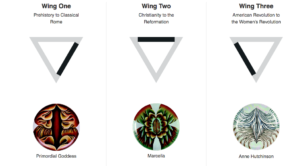
For more visuals on the Place Settings click here:
https://www.brooklynmuseum.org/eascfa/dinner_party/place_settings
———————————————————————————————————————————————————
Heritage Floor
The Dinner Party rests upon the Heritage Floor, which is an equilateral triangle forty-eight feet on each side. This monumental floor is comprised of 2,300 hand-cast porcelain tiles and provides both a structural and metaphorical support for The Dinner Party table. Inscribed in gold luster are the names of 999 mythical and historical women of achievement, who were selected to contextualize the 39 women represented in the place settings and to convey “how many women had struggled into prominence or been able to make their ideas known—sometimes in the face of overwhelming obstacles—only (like the women on the table) to have their hard-earned achievements marginalized or erased” (Chicago, The Dinner Party, 10).
Each tile was hand-cast and hand-sanded at the China Boutique outside of Los Angeles. The tiles were repeatedly fired with rainbow luster as well as with the gold luster used for the names. The process of creating the Heritage Floor took over two years. Potential names were researched by over twenty members of The Dinner Party‘s research team, headed by Diane Gelon and Ann Isolde. Out of three thousand names compiled, 999 were selected, their inclusion decided on by three criteria: did the woman make a worthwhile contribution to society; had she attempted to improve conditions for women; did her life/work exemplify a significant aspect of women’s history or provide a role model for a more egalitarian society? The chosen Heritage Floor names correlate to each of the 39 place settings by commonality of experience, historic contribution, time period, and/or geography.
The Heritage Floor serves as a visual representation of the vast contributions women have made to every aspect of history. Names of goddesses, mythological figures, religious figures, government leaders, entrepreneurs, writers, artists, musicians, actors, dancers, filmmakers, architects, scholars, historians, educators, military figures, athletes, physicians, scientists, explorers, philanthropists, activists, and suffragettes, primarily from western civilization, from prehistory to the 20th century, can be found on The Dinner Party‘s Heritage Floor.
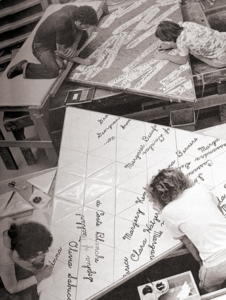
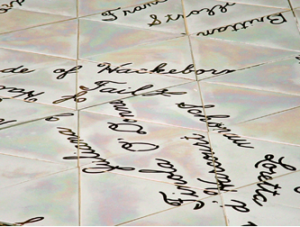
For more information on the making of the Heritage Floor click here:
https://www.brooklynmuseum.org/eascfa/dinner_party/heritage_floor/making/
For more detailed visuals of the Heritage Floor click here:
https://www.brooklynmuseum.org/eascfa/dinner_party/heritage_floor/detail/
———————————————————————————————————————————————————
Heritage Panels
The seven Heritage Panels are large-scale hand-colored photo-and-text collages (ranging in size from 57 1/2 x 70 3/4 to 57 1/2 x 107″) that portray the lives of the mythical and historical women whose names are inscribed in the Heritage Floor of The Dinner Party. Judy Chicago, with the help of a team of researchers, selected 999 women from prehistory to the 20th century, whose example impacted women’s history and the improvement of women’s conditions. Hand-written on porcelain tiles, these names make up the physical and symbolic foundation for The Dinner Party.
Like the Heritage Floor, the names listed on the Heritage Panels are organized beneath their corresponding place setting. The 999 names are accompanied by biographical information, photographs of related art and artifacts, and images of many of the women. To contextualize the importance of their legacies, Chicago also included brief passages describing the circumstances against which women had to struggle for equity throughout history.
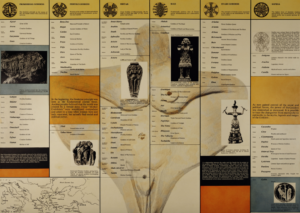
For more visuals on the Heritage Panels click here:
https://www.brooklynmuseum.org/eascfa/dinner_party/heritage_panels/panel
———————————————————————————————————————————————————
Acknowledgement Panels
Judy Chicago began The Dinner Party alone. After months of work, her concept had evolved to the stage where it required the assistance of other people. Gradually, a studio team was built, and over the course of the next few years, hundreds of volunteers helped the core staff of The Dinner Party studio to realize Chicago’s vision. They brought a variety of skills to the project including ceramics, needlework, fabrication, graphics, photography, and research, and worked together under Chicago’s guidance to complete the piece. The three mural-sized (94 3/4 x 48 1/4 x 1″ each) Acknowledgement Panels are a visual record crediting the collaborators for their commitment.
The Acknowledgment Panels depict the 129 members of the creative and administrative team with black-and-white photographs. Included in the panels are each participant’s name, occupation, residence, specific role and length of involvement in the project. The last panel lists the names of an additional 295 individuals and organizations not part of the studio team, who also made significant contributions.
While these panels are not included in the Brooklyn Museum installation, they are preserved at the Museum and presented here to recognize the multiple contributions that were made during the creation of this monumental work.
Judy Chicago writes of the experience: “The studio gradually became a structure of self-sufficient groups working under my guidance while also building teamwork through shared responsibility and honest dialogue”
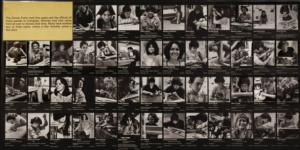
For more details on the Dinner Party Studio Team here:
https://www.brooklynmuseum.org/eascfa/dinner_party/acknowledgement_panels
For more visuals of the Acknowledgement Panels click here:
https://www.brooklynmuseum.org/eascfa/dinner_party/acknowledgement_panels/panel
 Place Settings:The principal component of The Dinner Party is a massive ceremonial banquet arranged in the shape of an open triangle—a symbol of equality—with a total of thirty-nine place settings.
Place Settings:The principal component of The Dinner Party is a massive ceremonial banquet arranged in the shape of an open triangle—a symbol of equality—with a total of thirty-nine place settings. Heritage Floor:The Dinner Party rests upon the Heritage Floor; inscribed on the tiles in gold luster are the names of 999 mythical and historical women of achievement who correlate to the 39 women represented in the place settings.
Heritage Floor:The Dinner Party rests upon the Heritage Floor; inscribed on the tiles in gold luster are the names of 999 mythical and historical women of achievement who correlate to the 39 women represented in the place settings.











